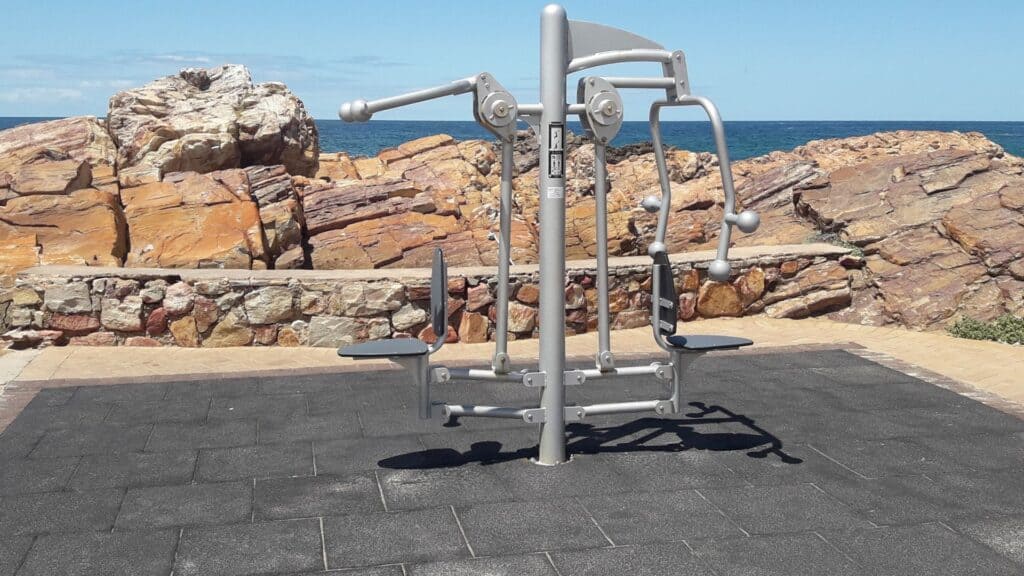Introduction
Are you looking for the best flooring options for your outside fitness facility? Don’t fret, we’re here to guide you through the various options. Outdoor gyms are a different animal, and they have unique requirements and necessities – especially with flooring. The construction of outdoor gyms is growing in popularity, allowing their users to exercise while enjoying the fresh air and open space. Choosing the right surface holds paramount importance if you are planning to open an outdoor gym. So, what are the factors you need to consider before making a choice?
This guide will give you the necessary knowledge for applying the best solution for your space. The flooring materials that work best for an outdoor gym include PVC, rubber, synthetic turf and asphalt. Read on to discover which surface works best to meet your requirements and consider the options available to you when creating the facility you’ve envisioned.
What is an outdoor gym?
Have you ever come across a setting in a park where people gather, performing callisthenics, and performing exercises on fixed bars and counterweighted pulleys? This a cool example of an outdoor gym. Another example could be your local gym utilising a large patio or rooftop space as a functional training zone or strength sports area.
Other examples include places such as Muscle Beach in Los Angeles as a fully equipped outdoor bodybuilding gym, or even garage PT studios that utilise their outdoor space for loaded carries and high-impact exercises, such as tyre flipping.

Factors to consider
Whether you want to create a damage-limiting zone for your garage gym or a high-end gym with an outdoor facility, you need a surface that is durable and weatherproof. When choosing the right flooring for your outside gym, you must consider the following:
Purpose – what will be the primary activity?
Budget – setting the amount that you wish to spend on your flooring will help you find the best solution for your space without compromising other areas of your project.
Location – define the exact area you want to use for your outdoor gym space, ideally with a floorplan or precise measurements.
Weather – consider the type of weather you experience in a typical year. Will your flooring have to withstand rain, sun, wind, or even snow? Is the area covered or exposed?
Drainage – determine whether the space has sufficient and efficient drainage, and adjust accordingly.
Maintenance – each flooring system comes with maintenance and cleaning requirements. An unsuitable surface will quickly deteriorate outdoors. The ideal surface must be easy to maintain without having to use harsh cleaning products.
Carefully considering these factors will assist you in deciding on the right type of flooring for your outdoor gym more effectively.
Which flooring materials work best for outdoor gyms?
After gym equipment, flooring remains the most important consideration. Whether an indoor gym or an outdoor gym, it must have appropriate flooring. The outdoor gym environment differs from that of the indoor gym, and unique factors like weather and atmosphere come into play. These factors shape the materials that are suitable for outdoor gym flooring.
As a practical example, outdoor gyms are more likely to have exposure to wet weather and humidity when compared to indoor gyms. For this reason, in the first instance, the flooring must be able to deal with standing water and moisture retention. Let’s have a look at the materials which are available and, more importantly, suited to the potential conditions of an outdoor gym.
PVC
Broadly, PVC materials are fantastic for gym flooring. They offer impact cushioning for dropped weights and have a long lifespan with great durability. In an outdoor gym scenario, other features show their advantage. A perforated plastic mat is superior as there is virtually zero water retention as it instantly drains, improving traction and reducing waiting time after bad weather.
Rubber flooring
Rubber is by far the most popular choice when it comes to gym flooring. It works well for both indoor gyms and outdoor gyms. It is naturally a non-slip surface, and if installed correctly, should offer decent drainage and durability.
Rubber flooring is supplied as rolls, mats, or tiles – based on the size of the space you wish to equip, and the thickness you require. Variations of rubber floors include:
- Bonded Rubber Mulch
- Styrene Butadiene Rubber (SBR)
- Rubber Tiles
Rubber tiles
Long-lasting, interlocking rubber tiles have multiple advantages. They are versatile yet durable and are suitable for use in weight rooms, gyms, basements, and outdoors. Installation is simple with an interlocking system, giving your surface an even and uniform appearance.
Resilient: Highly durable and resilient by nature, rubber tiles stand out from the crowd. They protect the floor from any kind of damage or wear, easily bearing the weight of exercise equipment. Price = quality = reliability.
Easy to install: Although we always recommend having flooring professionally installed, interlocking rubber mats are easy to install without too much fuss if your budget is tight. If you do go ahead and install the flooring yourself, it is essential to ensure the surface is hard and flat. This will ensure a safe and even surface.
Transportable: They are easy to detach and move, offering greater flexibility when it comes to requirements and rearranging equipment. As they are smaller in size, you can stack them somewhere out of the way when you don’t need them.
Artificial turf
Another option for outdoor gym flooring, artificial turf is ideal for those who want to offer HIIT and functional training. Install over an underlay to ensure safety and durability.
Flexible: Artificial turf is flexible in terms of moveability and the activities it facilitates. Its use is common in gyms, clubs, schools, and sports fields. In addition, it is highly durable and resistant to damaging UV light.
Easy maintenance: artificial turf is highly durable and designed for superior performance. It is easy to maintain by removing any debris.
Rubber playground tiles
Rubber playground tiles are the best option for garden areas, children’s play areas, recreational parks, and leisure centres. They have exceptional anti-fatigue and shock-absorbing qualities, can withstand all weather conditions, are super durable, and are easy to maintain. They vary in colour and thickness.
Shock-absorbant: According to research published by the American Standard Testing Methods (ASTM), tiles are safe for falls varying between 6 feet to 8 feet (1.8 m – 2.4 m).
ADA compliant: Wheelchair accessible for those who are differently able. A great choice whether you are using them for an outdoor gym or children’s playground.
Non-toxic chemicals: For those whose skin is sensitive to common environmental chemicals, the product constitutes premium quality rubber and other natural materials. EPDM rubber strengthens against cracks, and SBR rubber helps the surface remain supple.
Fall reduction: It is non-slip and porous, with excellent drainage, making it ideal for use in places with regular wet weather.
Asphalt/macadam flooring
Although not as popular as rubber or PVC flooring, it remains a good choice for outdoor gyms. Macadam isn’t suitable for areas where dropping weights is expected, but is a good fit for aerobic exercise areas. Combine macadam surfacing with other flooring materials such as rubber or PVC for more flexibility.
How can I maintain outdoor gym equipment?
Besides maintaining the flooring, your gym equipment is the most important thing. People use your gym because it has great equipment that is well-maintained.
Maintaining gym equipment is far more critical with outdoor gyms. The open environment creates a myriad of possibilities for gym equipment to degrade more rapidly. Outdoor gym owners or operators must bare in mind the requirements of a rigorous maintenance regimen.
Cover the equipment
A roof is vital as it protects the equipment from rain, snowfall, and ultraviolet rays from the sun. If the equipment is exposed to these elements, it leads to rust, and coatings fall off the equipment. An alternative to roofs is using a cover over the equipment.
Keeping equipment covered in bad weather is vital. Ideally, having a roof over the area will provide sufficient protection for equipment from rain, snowfall, and ultraviolet rays from the sun. If equipment is exposed, it will begin to rust, and protective coatings will begin to disintegrate.
Use Anti-rust treatment
Outdoor gym equipment tends to be affected by environmental humidity. Rainfall and sweat also make contact with gym equipment. Using an anti-rust treatment on the equipment will help, but ideally, you keep the equipment protected by covering and storing correctly.
Conclusion
Rubber-based flooring stands out as the best option to use for outdoor fitness spaces. It is tough and long-lasting, has an anti-porous surface and can withstand weather forces without loss of its core functionality. Choosing the right type of surface is vitally important if you want to give your outdoor gym maximum longevity, and provide your members with a safe yet unique exercise experience. Use this guide to help you with making the best decision for your facility based on the individual needs of your space and the activities you offer.
We do not sell equipment ourselves; we leave that to our suppliers. If you’re interested in finding out more about our service, please fill in this short form. We’ll do our best to provide a solution to your enquiry.
To comment on this article, please proceed to the LinkedIn post.
Disclaimer: The opinions and positions expressed in this publication are those of the authors and collaborators and do not necessarily reflect the views or policies of the professional fitness community.


